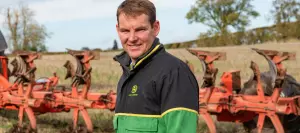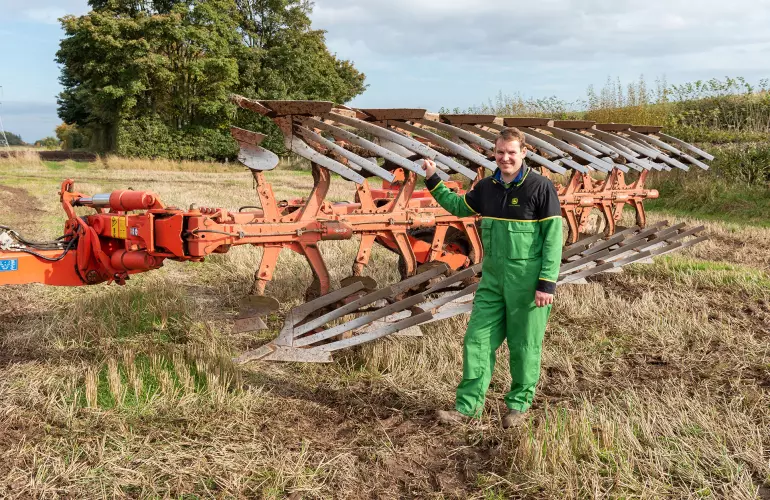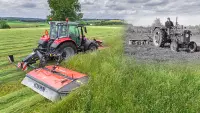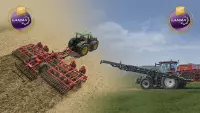PLOUGHING KEY TO EFFECTIVE ARABLE ROTATION
For farmer Stewart Cavers, the plough will always be an integral part of his farming operations, despite a significant shift towards minimum tillage over the past twenty years.

Of 1,900 acres of arable land farmed from Crosshall, near Greenlaw in the Scottish borders, he’s typically ploughing around a third each year, with this usually following the cropping rotation.
Whilst quick to acknowledge the merits of minimum tillage, he’s equally robust in his views of where the plough becomes irreplaceable.
“There’s no doubting the fact that our min till system allows us to cover the ground more quickly and is more economical on fuel,” says Stewart. “It’s also better for slug control ahead of oilseed rape, with the finer seedbed that’s created allowing rolling to be more effective.
“There are nevertheless key stages in the rotation where we’ll always choose to plough, to bury trash effectively and to maintain control of weed grasses such as sterile brome, which is an increasing threat up here.
“In general terms, we’ll plough before drilling winter barley and plough all the land that’s going into spring crops. It’s important to bury the weeds and to give these crops a cleaner start.”
Ploughing ahead of spring cropping is usually carried out in the autumn, allowing natural breakdown of the soil over the winter, but increased use of cover crops is creating a shift in policy.
“We started growing cover crops as part of our greening commitment and have seen real benefits, particularly on the hungrier ground,” says Stewart. “There’s a definite improvement in the workability of the soil, with greater levels of organic matter and more of the potash and phosphates being retained, so it’s something we’re doing more and more.”

A mix of black oats and phacelia is broadcast onto stubbles off the back of the min till cultivator in the autumn, creating a crop that can either be grazed or just left as cover before being sprayed and ploughed in.
“We cannot work the cover cropped ground until after the 1st January, but such is the improvement in the soil structure that it really is a doddle to plough once we do get on,” adds Stewart. “We have used the min till drill after cover crops, if they’ve been grazed, but generally speaking I’d say that having cover crops in the rotation is another good reason for having the option to plough.”
The 1,900 acre arable operation is part of a mixed farming operation, so grassland does form part of a rotation that includes first and second wheats, winter barley, oilseed rape, spring barley, spring oats and vining peas. The arable ground is a combination of owned, rented and contract farmed, predominantly on medium loam soils that can be heavy at times.
Winter cereals are mainly grown for feed, so yield is the priority with the wheat hitting 5 tonnes/acre and the barley 3.5-4 tonnes/acre in the better years. Spring crops are grown more for the premium markets, with most of the barley going for malting and the oats typically making the grade for porridge.
Stewart’s choice of plough is a semi-mounted seven furrow Kuhn Vari-Leader, which he readily admits is a sizeable piece of kit for the 500-600 acres that he’s turning over each year.
“We have the horsepower to pull a big plough and we want the capacity to be able to cover the ground when the windows of opportunity are short,” he says, “so this machine fits the bill for us very well. We generally run the plough on a 250hp JD7250, which pulls it no bother in-furrow, and we can easily do 50 acres a day when we need to.
“One of the main jobs of the plough is to bury trash and being semi-mounted this machine has the necessary under-beam clearance to do that comfortably.”
Weighing over four tonnes, the Vari-Leader stays in the ground, unlike other ploughs that Stewart has used, and he specified a wide tyre on its single wheel, to avoid any sinking when turning at the headlands. The plough is designed for good manoeuvrability, having a 110˚ headland turning radius despite its size, and is easy to set up.
“There’s very little to do in the set-up as everything apart from a couple of turn buckles is hydraulically controlled,” says Stewart. “We vary the furrow width according to conditions, going wider when working lighter soils and narrower when we want to break up the soil more aggressively.”

Stewart as opted for slatted mouldboards, which he finds are less likely to cause ‘bulldozing’ when working lighter fluffy soils and will leave a flatter finish for the following drill when used in the heavier conditions. The plough also has the non-stop hydraulic break back, a feature that provides a good level of protection but also maintains efficiency in work.
“We’ve a lot of stones in our ground, some the size or footballs, so the hydraulic break back is a real benefit for us,” he adds. “Overall, I’m very happy with the strength of the build and the durability of all the wearing parts.”
Having come through the very wet autumn of 2019, when he estimates an additional 100 acres went under the plough as opposed to min till due to the conditions, Stewart is as convinced as ever that he has the balance about right.
“There’s no better way to bury trash in my opinion,” he concludes, “and on a farm with rotational grassland playing and important role and cover crops showing their value, I cannot see a time when we won’t have the need for a good plough.”
Other News

Over 60 years of drum mower experience
In 1963, Dutchman Piet Zweegers jr. made an important invention: the cyclo mower, or drum mower. It would change the haymaking world forever...

Award-winning innovations from KUHN at LAMMA 2025
KUHN Farm Machinery will return to LAMMA for the first time in five years, showcasing an extensive range of products and innovations, with s...

TF 2300 C front hopper with double compartment
The new reference The world of farming is changing and cultivation methods are becoming more diverse: crop rotation, the use of multi-spe...
